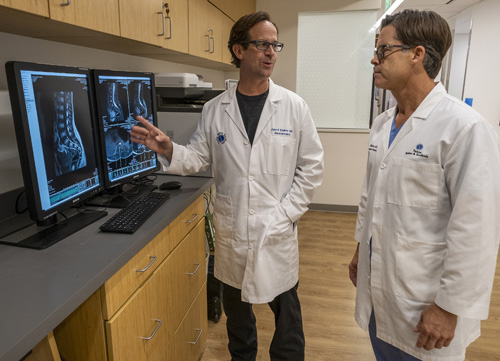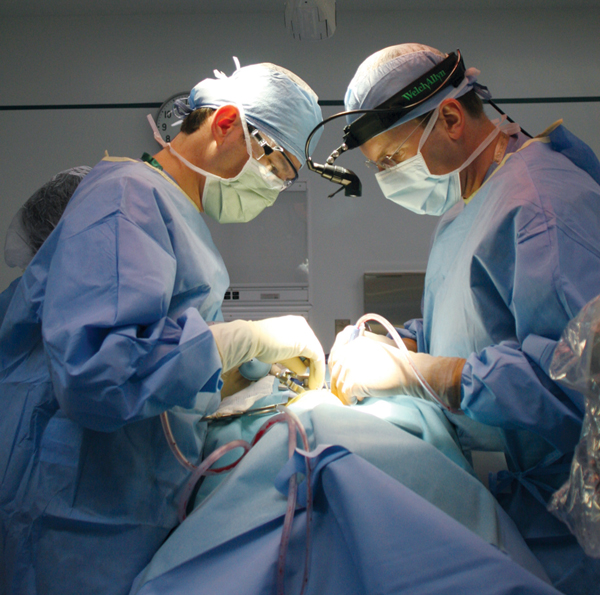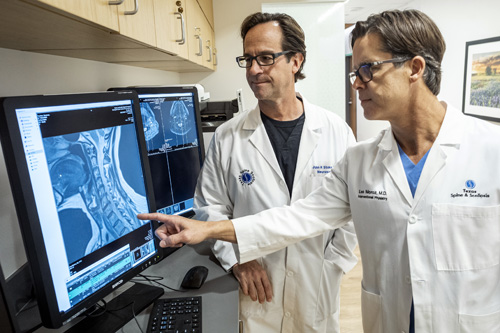
John K. Stokes, MD
Board-Certified Neurosurgeon
Fellowship-Trained in Spine Surgery
Co-Chief, Texas Spine and Scoliosis
Dr. Stokes is a board-certified neurosurgeon, fellowship-trained in spinal surgery with a practice entirely focused on spinal surgery. He has been in practice in Austin for more than 12 years and has performed thousands of spinal procedures. His practice serves as a referral center for general and complex spinal problems in the region. He maintains one of the busiest surgical practices in the region while practicing an ethical “conservative care first” philosophy.
Dr. Stokes was raised in East Texas and completed undergraduate training at the University of Texas- Austin in 1991 adding to a long family history of Longhorn graduates. Dr. Stokes subsequently obtained his medical degree from the University of Texas Health Science Center at San Antonio in 1995. He then began Neurosurgical training at the University of North Carolina becoming the Chief resident in Neurosurgery in 1996 and completing training there in 2001. A keen interest in spinal neurosurgery prompted advanced fellowship training at the Cedars-Sinai Institute for Spinal Disorders and UCLA ending in 2002. After completing his fellowship training, Dr. Stokes moved back to Austin with his family to practice spinal neurosurgery. He was named Co-chief of the Seton Spine and Scoliosis Center in 2009 and is the only fellowship-trained spinal neurosurgeon in the Seton Brain and Spine Institute.
Dr. Stokes obtained board certification from the American Board of Neurological Surgery in 2005 and remains a member in good standing. He is also a member of the American Association of Neurological Surgeons and the Congress of Neurological Surgeons. Dr. Stokes has and continues to publish numerous scientific articles in peer reviewed journals maintaining an active research interest in addition to his busy clinical practice. He was a principal investigator in the Mobi-C cervical artificial disc IDE (investigational device exemption) study. Recently, this artificial disc was the first to become FDA approved for two level implantation.

Special interests:
- Cervical artificial disc implantation
- Minimally invasive and endoscopic spine surgery
- Spinal cord and spinal column tumors
Clinical Services:
Degenerative spine
- Conservative care of degenerative spinal disorders
- Lumbar and Cervical artificial disc placement
- Minimally invasive cervical, thoracic and lumbar micro discectomy
- Endoscopic discectomy
- Minimally invasive spinal fusion
- Open spinal fusion
- Cervical, thoracic and lumbar decompression for stenosis
- Cervical, thoracic and lumbar reconstruction for instability
- Cervical and thoracic treatment of myelopathy
Tumors
- Primary tumors of the spinal cord and associated structures (glioma, meningioma, schwannoma, etc.)
- Primary tumors of the spinal column
- Metastatic tumors of the spinal column
Spinal Deformity
- Conservative care of adult spinal deformity
- Adult scoliosis surgery
- Adult kyphosis surgery
- Care for the previously operated scoliosis patient
- Complex spinal instrumentation

Do you qualify for an artificial disc?
By John Stokes, MD
Board-Certified Neurological Surgeon
Fellowship-trained in Spine Surgery
If you’ve been told that you have a herniated disc in your neck, you may also have been told by the spine surgeon that you need a spinal fusion. The educated patient should explore if that fusion is really the best option long term. Because the standard treatment for herniated discs in the neck has changed over the last five years, and it is also evolving for herniated discs in the low back.
First off, upon further research or with a second opinion, a person may learn that not all herniated discs require surgery. Some can respond to spine therapy or spinal injections to relieve symptoms of radiating pain or numbness in an arm or leg.
However, if non-surgical options fail to relieve the symptoms over a month or so, surgery is typically needed to remove the herniated disc and relieve the pressure on nearby nerve roots. Through a “discectomy” procedure, the damaged disc is removed which then require something is put back into that disc space to keep the vertebrae apart. That can be a bone graft that is inserted between the discs.
This can be the confusing part for a patient with a herniated disc in the neck, because there are many spine surgeons still recommending a spinal fusion for neck herniations. However, this is not always the best recommendation anymore.
Research presented at the North American Spine Society a few years ago documented that spinal fusion in the neck increased the risk of other herniations in the neck. Because the neck has only six disc levels separating the seven vertebrae, locking two levels together reduces the motion in the neck and increases the pressure on the five remaining discs.
A fusion surgery in the neck is called an Anterior Discectomy & Fusion (ACDF), which has been around since 1955. Each year about 150,000 ACDFs are performed. But the number of ACDF surgeries is now decreasing as cervical fusion surgery is replaced by artificial disc surgery in the neck.
The issue is how fast spine surgeons will embrace the most current technology for the patient. It takes significant training and expertise to perform artificial disc replacement, and some surgeons prefer traditional fusion because that is what they are most familiar with — even though there are great patient benefits realized from the motion preservation provided by the artificial disc.
While disc replacement is becoming more commonplace for neck herniations, the same is not yet the case for herniated discs in the low back. There are several reasons for this. One is that the artificial disc technology is still evolving for the low back. While there is less weight placed on the artificial disc in the neck, the discs in the low back have the complete weight of the body and there is more shock absorption needed. The second reason is that accessing the discs in the low back is more complex as surgery involves accessing the disc through the abdomen and around internal organs. Thirdly, there is a concern that the extra weight on the artificial disc in the low back could wear out the disc over 15 to 20 years, which would require replacement surgery which is very complex at a time when the patient is older and has more risk related to any surgery.
With lumbar spine surgery the biggest advance relates to replacing the standard 3-inch incision with a tiny half inch incision where the spine surgeon accesses the disc through a tubular retractor the width of a ball point pen. These patients can go home later the same day, have less blood loss, and less pain in recovery than those who receive a 3-inch incision.
It’s important to remember that the most advanced spine surgery capabilities, both minimally invasive spine surgery through half inch incisions, and artificial disc replacement, are rarely found in small cities. In smaller cities, a person is more likely to find surgeons who split their time between general orthopedics, brain surgery and spine surgery. Not ideal. The ideal is to find a spine specialist who spends 100% of their time on spine surgery, not hips, not knees and not brain surgery. Those are all specialties unto themselves with the same concerns about using the most advanced techniques and instrumention in those niches.
It’s simply not realistic to expect a general orthopedic surgeon or general neurosurgeon to be as proficient with new instruments and artificial discs as a spine surgeon who performs 100 of these surgeries a year. Like anything else, practice makes perfect. The more often a spine surgeon implants an artificial disc the better they get at it and the better the patient’s clinical outcome. Consequently, if you’ve been told you need spine surgery, you will have to travel to a larger city to find a spine surgeon who does a high volume of minimally invasive spine surgery and artificial disc replacement.

Here is some good advice for patients with neck symptoms they suspect are from a herniated disc.
1. For neck herninations, artificial disc replacement can help preserve the natural motion in the neck which can reduce the risk of future herniations.
If you’ve been told you need an ACDF without any consideration for if you qualify for an artificial disc in the neck, you should get a second opinion from another spine surgeon who is proficient in artificial disc replacement. The other reason to do your research on this is because once you have a fusion, it typically can’t be reversed. The issue is that the bone graft can often become fused to the facet joints at the back of the spine. Cutting out and removing the bone graft can then cause a new pain symptom related to the disrupted facet joints. This is why you should determine if you qualify for an artificial disc at the first surgery decision point.
2. Not all neck herniations are appropriate for artificial disc replacement.
While motion preservation is the ideal, not everybody qualifies to have their herniated disc replaced with an artificial implant. If your surgeon is proficient in artificial disc surgery and does not think you are appropriate for it, he probably has determined correctly that you would not have a good outcome from an artificial disc implant.
3. There are many serious neck problems that have similar symptoms but are NOT related to a herniated disc.
Cervical myelopathy and spinal stenosis in the neck may have similar symptoms but relates to compression of the spinal cord rather than a disc herniation. Symptoms can include numbness or pins and needles sensation in the hands, stiffness in the neck or even issues with walking. Cervical myelopathy is a serious condition that if left untreated it can lead to permanent nerve damage including paralysis. Prompt spine surgery is often needed to relieve pressure on the spinal cord.
Spinal stenosis is somewhat common in those over 50 or 60 years of age and relates to bone spurs compressing the spinal cord like a ring on a swollen finger. Spinal stenosis can cause pain as a person arches their back. The good news is that the spine surgery involved is relatively straightforward and outcomes are good.
4. There are other non-disc related issues in the low back.
Lumbar spondylolyssis is a stress fracture of the pars interarticularis in the lumbar vertebrae— a thin bone segment joining two vertebrae. Symptoms of lumbar spondylolyssis includes pain that worsens with running. It can often improve with rest. Lumbar spondylolisthesis is where the cracked vertebra actually slips forward out of position causing instability in the spine. While symptoms can be relieved with rest, surgery may be needed to install instrumentation to stabilize the spine. Lumbar spondylolyssis condition is found in one out of every 20 people but according to the National Institues on health, however, up to 75% of these people may develop spondylolisthesis. Both problems can occur with age, but younger female gymnastics have higher risk. According to National Institutes on Health, spondylolysis and spondylolisthesis affects 10% to 50% of female gymnasts.
5. Be willing to travel to a spine center of excellence for your back or neck.
In summary, if you’ve been diagnosed with a herniated disc in your neck or your back, be willing to travel to a regional spine center that specializes in neck and back surgery, including artificial disc replacement and minimally invasive spine surgery. That way you will be confident that you are receiving the most advanced treatment with the best long term outcome.
Dr. John Stokes is a fellowship-trained neurological spine surgeon and is co-chief of Texas Spine and Scoliosis, which is a regional spine center of excellence based in Austin that is referred complex back and neck patients, spinal tumor patients and scoliosis patients from across Texas, Oklahoma, Louisiana and Arkansas. The regional spine center is referred international patients from cities across Mexico — including Mexico City, Monterrey, Hermosillo and Merida. Patients come to the spine center for second opinions for minimally invasive spine surgery; spinal tumor and artificial disc replacement. Texas Spine and Scoliosis has offices in Central Austin; Round Rock/Georgetown; Burnet/Marble Falls; and Kyle, Texas, which is just north of San Antonio.




